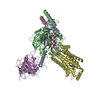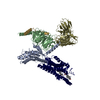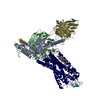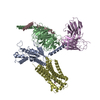登録情報 データベース : PDB / ID : 7rkyタイトル Binding mode of US27-Gi-scFv16 in OCL-state (Guanine nucleotide-binding protein ...) x 3 Antibody fragment scFv16 G-protein coupled receptor homolog US27 キーワード / / / / 機能・相同性 分子機能 ドメイン・相同性 構成要素
/ / / / / / / / / / / / / / / / / / / / / / / / / / / / / / / / / / / / / / / / / / / / / / / / / / / / / / / / / / / / / / / / / / / / / / / / / / / / / / / / / / / / / / / / / / / / / / / / / / / / / / / / / / / / / / / / / / / / / / / / / / / / / / / / / / / / / / / / / / / / / / / / / / / / / / / / / / / / / / / / / / / / / / 生物種 Homo sapiens (ヒト)Mus musculus (ハツカネズミ)手法 / / / 解像度 : 3.8 Å データ登録者 Tsutsumi, N. / Jude, K.M. / Garcia, K.C. 資金援助 組織 認可番号 国 National Institutes of Health/National Institute Of Allergy and Infectious Diseases (NIH/NIAID) R01AI125320 Howard Hughes Medical Institute (HHMI)
ジャーナル : Sci Adv / 年 : 2022タイトル : Atypical structural snapshots of human cytomegalovirus GPCR interactions with host G proteins著者 : Tsutsumi, N. / Maeda, S. / Qu, Q. / Voegele, M. / Jude, K.M. / Suomivuori, C.M. / Panova, O. / Waghray, D. / Kato, H.E. / Velasco, A. / Dror, R.O. / Skiniotis, G. / Kobilka, B.K. / Garcia, K.C. 履歴 登録 2021年7月22日 登録サイト / 処理サイト 改定 1.0 2022年1月26日 Provider / タイプ 改定 1.1 2024年11月6日 Group / Structure summaryカテゴリ chem_comp_atom / chem_comp_bond ... chem_comp_atom / chem_comp_bond / em_admin / pdbx_entry_details / pdbx_modification_feature Item / _pdbx_entry_details.has_protein_modification
すべて表示 表示を減らす
 データを開く
データを開く 基本情報
基本情報 要素
要素 キーワード
キーワード 機能・相同性情報
機能・相同性情報 Homo sapiens (ヒト)
Homo sapiens (ヒト)

 Human cytomegalovirus (ヘルペスウイルス)
Human cytomegalovirus (ヘルペスウイルス) データ登録者
データ登録者 米国, 2件
米国, 2件  引用
引用 ジャーナル: Sci Adv / 年: 2022
ジャーナル: Sci Adv / 年: 2022 構造の表示
構造の表示 ムービービューア
ムービービューア Molmil
Molmil Jmol/JSmol
Jmol/JSmol ダウンロードとリンク
ダウンロードとリンク ダウンロード
ダウンロード 7rky.cif.gz
7rky.cif.gz PDBx/mmCIF形式
PDBx/mmCIF形式 pdb7rky.ent.gz
pdb7rky.ent.gz PDB形式
PDB形式 7rky.json.gz
7rky.json.gz PDBx/mmJSON形式
PDBx/mmJSON形式 その他のダウンロード
その他のダウンロード 7rky_validation.pdf.gz
7rky_validation.pdf.gz wwPDB検証レポート
wwPDB検証レポート 7rky_full_validation.pdf.gz
7rky_full_validation.pdf.gz 7rky_validation.xml.gz
7rky_validation.xml.gz 7rky_validation.cif.gz
7rky_validation.cif.gz https://data.pdbj.org/pub/pdb/validation_reports/rk/7rky
https://data.pdbj.org/pub/pdb/validation_reports/rk/7rky ftp://data.pdbj.org/pub/pdb/validation_reports/rk/7rky
ftp://data.pdbj.org/pub/pdb/validation_reports/rk/7rky リンク
リンク 集合体
集合体
 要素
要素 Homo sapiens (ヒト) / 遺伝子: GNAI1 / 発現宿主:
Homo sapiens (ヒト) / 遺伝子: GNAI1 / 発現宿主:  Trichoplusia ni (イラクサキンウワバ) / 参照: UniProt: P63096
Trichoplusia ni (イラクサキンウワバ) / 参照: UniProt: P63096 Homo sapiens (ヒト) / 遺伝子: GNB1 / 発現宿主:
Homo sapiens (ヒト) / 遺伝子: GNB1 / 発現宿主:  Trichoplusia ni (イラクサキンウワバ) / 参照: UniProt: P62873
Trichoplusia ni (イラクサキンウワバ) / 参照: UniProt: P62873 Homo sapiens (ヒト) / 遺伝子: GNG2 / 発現宿主:
Homo sapiens (ヒト) / 遺伝子: GNG2 / 発現宿主:  Trichoplusia ni (イラクサキンウワバ) / 参照: UniProt: P59768
Trichoplusia ni (イラクサキンウワバ) / 参照: UniProt: P59768


 Trichoplusia ni (イラクサキンウワバ)
Trichoplusia ni (イラクサキンウワバ)
 Human cytomegalovirus (ヘルペスウイルス)
Human cytomegalovirus (ヘルペスウイルス) Homo sapiens (ヒト) / 参照: UniProt: P09703
Homo sapiens (ヒト) / 参照: UniProt: P09703 試料調製
試料調製 電子顕微鏡撮影
電子顕微鏡撮影
 FIELD EMISSION GUN / 加速電圧: 300 kV / 照射モード: FLOOD BEAM
FIELD EMISSION GUN / 加速電圧: 300 kV / 照射モード: FLOOD BEAM 解析
解析 ムービー
ムービー コントローラー
コントローラー




















 PDBj
PDBj






























